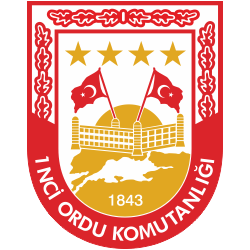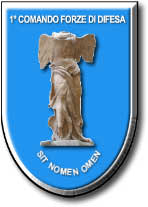
The First Army of the Republic of Turkey is one of the four field armies of the Turkish Army. Its headquarters is located at Selimiye Barracks in Istanbul. It guards the sensitive borders of Turkey with Greece and Bulgaria, including the straits Bosporus and Dardanelles. The First Army is stationed in East Thrace.

The Turkish Land Forces, or Turkish Army, is the main branch of the Turkish Armed Forces responsible for land-based military operations. The army was formed on November 8, 1920, after the collapse of the Ottoman Empire. Significant campaigns since the foundation of the army include suppression of rebellions in Southeast Anatolia and East Anatolia from the 1920s to the present day, combat in the Korean War, the 1974 Turkish invasion of Cyprus and the current Turkish involvement in the Syrian Civil War, as well as its NATO alliance against the USSR during the Cold War. The army holds the preeminent place within the armed forces. It is customary for the Chief of the General Staff of the Turkish Armed Forces to have been the Commander of the Turkish Land Forces prior to his appointment as Turkey's senior ranking officer.

The Syrian Army, officially the Syrian Arab Army, is the land force branch of the Syrian Armed Forces. It is the dominant military service of the four uniformed services, controlling the most senior posts in the armed forces, and has the greatest manpower, approximately 80 percent of the combined services. The Syrian Army originated in local military forces formed by the French after World War I, after France obtained a mandate over the region. It officially came into being in 1945, before Syria obtained full independence the following year.
A tank corps was a type of Soviet armoured formation used during World War II.
A mechanised corps was a Soviet armoured formation used prior to the beginning of World War II and reintroduced during the war, in 1942.

The Bulgarian Land Forces are the ground warfare branch of the Bulgarian Armed Forces. It is administered by the Ministry of Defence, previously known as the Ministry of War during the Kingdom of Bulgaria. The Land Forces were established in 1878, when they were composed of anti-Ottoman militia (opalchentsi) and were the only branch of the Bulgarian military.

The 7th Mechanized Division is a mechanized infantry division of the Syrian Arab Army. It was established in 1970. The division is part of the Syrian Army's 1st Corps.

This is the order of battle for the ground campaign in the Gulf War between U.S. and Coalition Forces and the Iraqi Armed Forces between February 24–28, 1991. The order that they are listed in are from west to east. Iraqi units that were not in the Kuwaiti Theater of Operations are excluded from this list. Some Iraqi divisions remained un-identified by Department of Defense intelligence and a number of the details of the Iraqi order of battle are in dispute among various authoritative sources.

This is the order of battle for the invasion of Iraq during the Iraq War between coalition forces and the Iraqi Armed Forces; Fedayeen Saddam irregulars; and others between March 19 and May 1, 2003.

The Soviet order of battle for Operation Uranus details the combat units of the Soviet forces that fought in Operation Uranus, the Soviet strategic counteroffensive that led to the encirclement of the German troops in Stalingrad. The order of battle lists units present on 19 November 1942, the day the operation began, from north to south.

The 4th Armoured Division is an elite formation of the Syrian Army whose primary purpose is to defend the Syrian government from internal and external threats. The division is considered one of the most combat-ready formations of the Syrian Arab Army. It played a key role in some battles of the Syrian Civil War.

The 15th Special Forces Division is a division of the Syrian Armed Forces specializing in light infantry operations, based in the As-Suwayda Governorate. The Division is part of the Syrian Army's 1st Corps.

The 5th Mechanized Division is a mechanized infantry division of the Syrian Arab Army. The division is part of the Syrian Army's 1st Corps.

The 1st Armoured Division is an armored division of the Syrian Arab Army. It was established in 1970 and is part of the 2nd Corps. The 1st Division is the largest formation of the Syrian Arab Army.

The V Army Corps was one of three corps the Italian Army fielded during the Cold War. Based in the regions of Veneto and Friuli-Venezia-Giulia the corps was the army's main combat force. The 5th Army Corps was arrayed close to the Yugoslavian border and tasked with meeting any Warsaw Pact forces that crossed the border. On the left flank of the corps the 4th Alpine Army Corps was tasked with blocking the Alpine passes and in the rear of the corps the 3rd Army Corps served as operational reserve. After the end of the Cold War the corps was reduced in size and on 1 October 1997 it became the 1st Defence Forces Command. In 2013 the COMFOD 1° was disbanded and its function and brigades taken over by the 20th Infantry Division Friuli in Florence.

The 3rd Armoured Division is a formation of the Syrian Army responsible for securing the northern approach to Damascus. The division is based in a military complex near Qutayfah and has traditionally been seen as one of the Syrian Armed Force's most reliable conventional divisions. The division is part of the 3rd Corps.

The 9th Armoured Division is an elite division of the Syrian Arab Army, part of the 1st Army Corps and it was established in 1970.

The Cuban Revolutionary Army serve as the ground forces of Cuba. Formed in 1868 during the Ten Years' War, it was originally known as the Cuban Constitutional Army. Following the Cuban Revolution, the revolutionary military forces was reconstituted as the national army of Cuba by Fidel Castro in 1960. The army is a part of the Cuban Revolutionary Armed Forces which was founded around that time.

The 2nd Corps is a corps of the Syrian Army that was first formed in 1985. Richard Bennett wrote in 2001 that "three corps [were] formed in 1985 to give the Army more flexibility and to improve combat efficiency by decentralising the command structure, absorbing at least some of the lessons learned during the 1982 Lebanon War." He said that the 2nd Corps with HQ in Zabadani, covered north of Damascus, whole Homs and included Lebanon. In November 2019, Major General Abdul Majeed Ibrahim was appointed as commander of the 2nd Army Corps of the Syrian Arab Army.

The 3rd Corps is a corps of the Syrian Army that was first formed in 1985. Richard Bennett wrote in 2001 that "three corps were formed in 1985 to give the Army more flexibility and to improve combat efficiency by decentralising the command structure, absorbing at least some of the lessons learned during the 1982 Lebanon War." The 3rd Corps HQ was in Aleppo, based in the north and covered Hama, the Turkish and Iraqi borders, the Mediterranean coastline and was tasked with protecting the complex of chemical and biological warfare and missile production and launch facilities. On 30 December 2023, Major General Ahmed Moalla was named as commander of the 3rd Corps.













